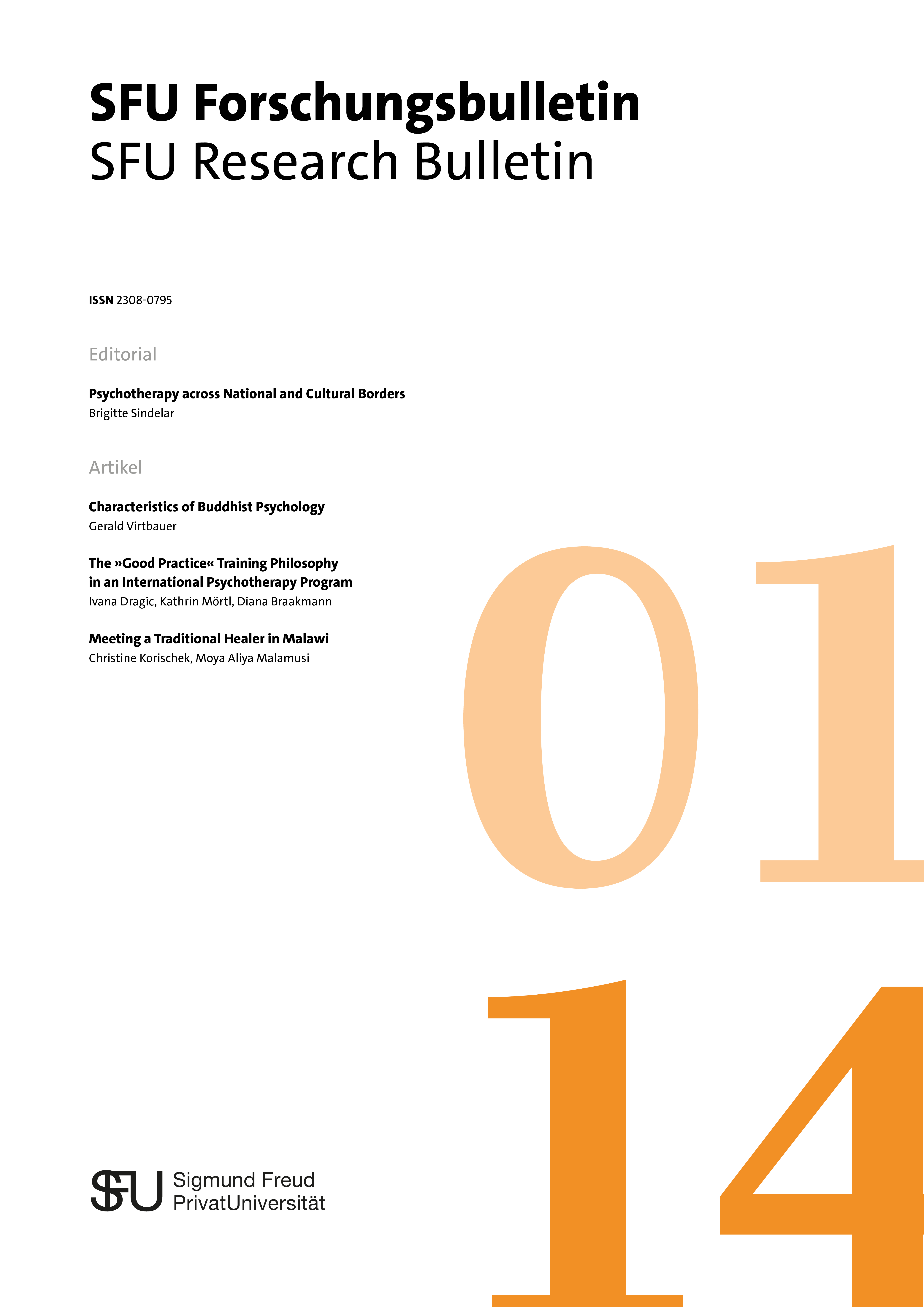Characteristics of Buddhist Psychology
DOI:
https://doi.org/10.15135/2014.2.1.1-9Abstract
Five characteristics of Buddhist psychology are explained — Buddhist psychology as a psychological, phenomenological, pragmatic, empirical, and therapeutic system. This explanation facilitates the understanding of the importance of indigenous Buddhist psychology within current psychotherapy science.
References
(Abbreviation: PTS – Pali Text Society ed. [references to volume and page(s)])
AN — Aṅguttara Nikāya. PTS.
Anālayo. (2003). Satipaṭṭhāna: the direct path to realization. Cambridge: Windhorse Publications.
Bechert, H. (2004). Buddha, Life of the. In R. E. Buswell, Jr. (Ed.), Encyclopedia of Buddhism (Vol. 1, pp. 82–88). New York: Macmillan Reference USA.
Berry, J. W., Poortinga, Y. H., Breugelmans, S. M., Chasiotis, A., & Sam, D. L. (2011). Cross-cultural psychology: research and applications (3rd ed.). Cambridge: Cambridge University Press.
Bhawuk, D. P. S. (2010). Methodology for building psychological models from scriptures: contributions of Indian psychology to indigenous and universal psychologies. Psychology and Developing Societies, 22(1), 49–93. doi: 10.1177/097133360902200103
Bodhi, B. (Ed.). (2007). A comprehensive manual of Abhidhamma: the philosophical psychology of Buddhism. The Abhidhammattha Saṅgaha of Ācariya Anuruddha (3rd ed.). Kandy, Sri Lanka: Buddhist Publication Society.
DN — Dīgha Nikāya. PTS.
Farb, N. A. S., Anderson, A. K., Mayberg, H., Bean, J., McKeon, D., & Segal, Z. V. (2010). Minding one’s emotions: mind-fulness training alters the neural expression of sadness. Emotion, 10(1), 25–33. doi: 10.1037/A0017151
Farb, N. A. S., Segal, Z. V., Mayberg, H., Bean, J., McKeon, D., Fatima, Z., & Anderson, A. K. (2007). Attending to the present: mindfulness meditation reveals distinct neural modes of self-reference. Social Cognitive and Affective Neuroscience, 2(4), 313–322. doi: 10.1093/Scan/Nsm030
Gombrich, R. F. (2009). What the Buddha thought. Sheffield: Equinox Publishing.
Harvey, P. (2000). An introduction to Buddhist ethics: foundations, values, and issues. Cambridge: Cambridge University Press.
Hayes, S. C., Follette, V. M., & Linehan, M. M. (Eds.). (2004). Mindfulness and acceptance: expanding the cognitivebehavioral tradition. New York: Guilford Press.
Heidenreich, T., & Michalak, J. (Eds.). (2004). Achtsamkeit und Akzeptanz in der Psychotherapie: Ein Handbuch. Tübingen: dgvt-Verlag.
Kuan, T.-f. (2008). Mindfulness in early Buddhism: new approaches through psychology and textual analysis of Pali, Chinese and Sanskrit sources. London: Routledge.
Mikulas, W. L. (2011). Mindfulness: significant common confusions. Mindfulness, 2(1), 1–7. doi: 10.1007/s12671-010-0036-z
MN — Majjhima Nikāya. PTS.
Ñāṅananda, B. (1976). Concept and reality in early Buddhist thought: an essay on “papañca” and “papañca-saññā-saṅkhā” (2nd ed.). Kandy, Sri Lanka: Buddhist Publication Society.
Rao, K. R. (2008). Prologue: introducing Indian psychology. In K. R. Rao, A. C. Paranjpe & A. K. Dalal (Eds.), Handbook of Indian psychology (pp. 1–19). New Delhi: Cambridge University Press India.
Rapgay, L., & Bystrisky, A. (2009). Classical mindfulness: an introduction to its theory and practice for clinical application. Longevity, Regeneration, and Optimal Health: Integrating Eastern and Western Perspectives; Annals of the New York Academy of Sciences, 1172, 148–162. doi: 10.1111/J.1749-6632.2009.04405.X
Rapgay, L., Bystritsky, A., Dafter, R. E., & Spearman, M. (2011). New strategies for combining mindfulness with integrative cognitive behavioral therapy for the treatment of generalized anxiety disorder. Journal of rational-emotive and cognitive-behavior therapy, 29(2), 92–119.
Safran, J. D. (Ed.). (2003). Psychoanalysis and Buddhism: an unfolding dialogue. Boston: Wisdom Publications.
Segal, Z. V., Williams, J. M. G., & Teasdale, J. D. (2002). Mindfulness-based cognitive therapy for depression: a new approach to preventing relapse. New York: Guilford Press.
SN — Saṃyutta Nikāya. PTS.
Soma, T. (Trans.). (1959/2008). Kālāma Sutta: the Buddha’s charter of free inquiry. The Wheel Publication No. 8, (pp. 7). Retrieved July 3, 2013, from http://www.bps.lk/olib/wh/wh008.pdf
Virtbauer, G. (2008). Psychologie im Erkenntnishorizont des Mahāyāna-Buddhismus: Interdependenz und Intersubjektivität im Beziehungserleben. Frankfurt am Main: Peter Lang.
Virtbauer, G. (2009). Das Zen-buddhistische Selbst-Konzept. Eine Erläuterung anhand Dōgen Zenji’s Shōbōgenzō. e-Journal Philosophie der Psychologie, 12. Retrieved from http://www.jp.philo.at/texte/VirtbauerG1.pdf
Virtbauer, G. D. (2010). Dimensions of intersubjectivity in Mahāyāna-Buddhism and relational psychoanalysis. Contemporary Buddhism, 11(1), 85–102. doi: 10.1080/14639941003791584
Virtbauer, G. (2011). Bewusstsein und Beziehung im Mahāyāna-Buddhismus. Ein integrativ religionspsychologischer Ansatz. e-Journal Philosophie der Psychologie, 15. Retrieved from http://www.jp.philo.at/texte/VirtbauerG2.pdf
Virtbauer, G. (2012). The Western reception of Buddhism as a psychological and ethical system: developments, dialogues, and perspectives. Mental Health, Religion & Culture, 15(3), 251–263. doi: 10.1080/13674676.2011.569928
Virtbauer, G. (2013). Bewusstsein und Achtsamkeit in der buddhistischen Psychologie. In U. Anderssen-Reuster, S. Meck & P. Meibert (Eds.), Psychotherapie und buddhistisches Geistestraining: Methoden einer achtsamen Bewusstseinskultur (pp. 263–276). Stuttgart: Schattauer.
Vism — The path of purification (Visuddhimagga) by Bhadantācariya Buddhaghosa. (1957/1999). (B. Ñāṇamoli, Trans.). Onalaska, WA: BPS Pariyatti Editions. [references to chapter and paragraph(s)]
Warder, A. K. (1991). Introduction to Pali (3rd ed.). Oxford: Pali Text Society. (1st ed. 1963)
Williams, J. M. G., & Kabat-Zinn, J. (2011). Mindfulness: diverse perspectives on its meaning, origins, and multiple applications at the intersection of science and dharma. Contemporary Buddhism, 12(1), 1–18. doi: 10.1080/14639947.2011.564811
Downloads
Published
Issue
Section
License
The reproduction of articles published in any form is allowed under the condition that the citation is comprehensive. Prints in other publication media or public media require the written consent of the editor and can be requested under: forschung@sfu.ac.at
